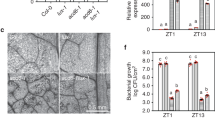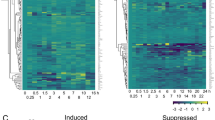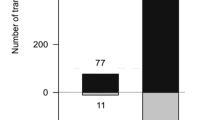Abstract
The principal immune mechanism against biotrophic pathogens in plants is the resistance (R)-gene-mediated defence1. It was proposed to share components with the broad-spectrum basal defence machinery2. However, the underlying molecular mechanism is largely unknown. Here we report the identification of novel genes involved in R-gene-mediated resistance against downy mildew in Arabidopsis and their regulatory control by the circadian regulator, CIRCADIAN CLOCK-ASSOCIATED 1 (CCA1). Numerical clustering based on phenotypes of these gene mutants revealed that programmed cell death (PCD) is the major contributor to resistance. Mutants compromised in the R-gene-mediated PCD were also defective in basal resistance, establishing an interconnection between these two distinct defence mechanisms. Surprisingly, we found that these new defence genes are under circadian control by CCA1, allowing plants to ‘anticipate’ infection at dawn when the pathogen normally disperses the spores and time immune responses according to the perception of different pathogenic signals upon infection. Temporal control of the defence genes by CCA1 differentiates their involvement in basal and R-gene-mediated defence. Our study has revealed a key functional link between the circadian clock and plant immunity.
This is a preview of subscription content, access via your institution
Access options
Subscribe to this journal
Receive 51 print issues and online access
$199.00 per year
only $3.90 per issue
Buy this article
- Purchase on Springer Link
- Instant access to full article PDF
Prices may be subject to local taxes which are calculated during checkout



Similar content being viewed by others
References
Jones, J. D. & Dangl, J. L. The plant immune system. Nature 444, 323–329 (2006)
Tao, Y. et al. Quantitative nature of Arabidopsis responses during compatible and incompatible interactions with the bacterial pathogen Pseudomonas syringae . Plant Cell 15, 317–330 (2003)
Roden, L. C. & Ingle, R. A. Lights, rhythms, infection: the role of light and the circadian clock in determining the outcome of plant–pathogen interactions. Plant Cell 21, 2546–2552 (2009)
Lam, E., Kato, N. & Lawton, M. Programmed cell death, mitochondria and the plant hypersensitive response. Nature 411, 848–853 (2001)
Donofrio, N. M. & Delaney, T. P. Abnormal callose response phenotype and hypersusceptibility to Peronospoara parasitica in defence-compromised Arabidopsis nim1–1 and salicylate hydroxylase-expressing plants. Mol. Plant Microbe Interact. 14, 439–450 (2001)
Holub, E. B., Beynon, J. L. & Crute, I. R. Phenotypic and genotypic characterization of interactions between isolates of Peronospora parasitica and accessions of Arabidopsis thaliana . Mol. Plant Microbe Interact. 7, 223–239 (1994)
van der Biezen, E. A., Freddie, C. T., Kahn, K., Parker, J. E. & Jones, J. D. Arabidopsis RPP4 is a member of the RPP5 multigene family of TIR-NB-LRR genes and confers downy mildew resistance through multiple signalling components. Plant J. 29, 439–451 (2002)
McDowell, J. M. et al. Downy mildew (Peronospora parasitica) resistance genes in Arabidopsis vary in functional requirements for NDR1, EDS1, NPR1 and salicylic acid accumulation. Plant J. 22, 523–529 (2000)
Chinchilla, D. et al. A flagellin-induced complex of the receptor FLS2 and BAK1 initiates plant defence. Nature 448, 497–500 (2007)
Kemmerling, B. et al. The BRI1-associated kinase 1, BAK1, has a brassinolide-independent role in plant cell-death control. Curr. Biol. 17, 1116–1122 (2007)
Heese, A. et al. The receptor-like kinase SERK3/BAK1 is a central regulator of innate immunity in plants. Proc. Natl Acad. Sci. USA 104, 12217–12222 (2007)
Harmer, S. L. et al. Orchestrated transcription of key pathways in Arabidopsis by the circadian clock. Science 290, 2110–2113 (2000)
Harmer, S. L. & Kay, S. A. Positive and negative factors confer phase-specific circadian regulation of transcription in Arabidopsis . Plant Cell 17, 1926–1940 (2005)
Michael, T. P. et al. Network discovery pipeline elucidates conserved time-of-day-specific cis-regulatory modules. PLoS Genet. 4, e14 (2008)
Slusarenko, A. & Schlaich, N. L. Downy Mildew of Arabidopsis thaliana caused by Hyaloperonospora parasitica (formerly Peronospora parasitica). Mol. Plant Pathol. 4, 159–170 (2003)
Salome, P. A. & McClung, C. R. PSEUDO-RESPONSE REGULATOR 7 and 9 are partially redundant genes essential for the temperature responsiveness of the Arabidopsis circadian clock. Plant Cell 17, 791–803 (2005)
Wang, Z. Y. & Tobin, E. M. Constitutive expression of the CIRCADIAN CLOCK ASSOCIATED 1 (CCA1) gene disrupts circadian rhythms and suppresses its own expression. Cell 93, 1207–1217 (1998)
Schaffer, R. et al. The late elongated hypocotyl mutation of Arabidopsis disrupts circadian rhythms and the photoperiodic control of flowering. Cell 93, 1219–1229 (1998)
Yeakley, J. M. et al. Profiling alternative splicing on fiber-optic arrays. Nature Biotechnol. 20, 353–358 (2002)
Tamayo, P. et al. Metagene projection for cross-platform, cross-species characterization of global transcriptional states. Proc. Natl Acad. Sci. USA 104, 5959–5964 (2007)
Bryant, P. A., Trinder, J. & Curtis, N. Sick and tired: does sleep have a vital role in the immune system? Nature Rev. Immunol. 4, 457–467 (2004)
Tor, M. et al. Arabidopsis SGT1b is required for defense signaling conferred by several downy mildew resistance genes. Plant Cell 14, 993–1003 (2002)
Brady, S. M. et al. A high-resolution root spatiotemporal map reveals dominant expression patterns. Science 318, 801–806 (2007)
Bowling, S. A., Clarke, J. D., Liu, Y., Klessig, D. F. & Dong, X. The cpr5 mutant of Arabidopsis expresses both NPR1-dependent and NPR1-independent resistance. Plant Cell 9, 1573–1584 (1997)
Suzuki, R. & Shimodaira, H. Pvclust: an R package for assessing the uncertainty in hierarchical clustering. Bioinformatics 22, 1540–1542 (2006)
Adam, L. & Somerville, S. C. Genetic characterization of five powdery mildew resistance loci in Arabidopsis thaliana . Plant J. 9, 341–356 (1996)
Cao, H., Bowling, S. A., Gordon, S. & Dong, X. Characterization of an Arabidopsis mutant that is nonresponsive to inducers of systemic acquired resistance. Plant Cell 6, 1583–1592 (1994)
Acknowledgements
We thank S. Brady for performing mixed model ANOVA of the data and advice on data analyses; J. Li for sharing the protocol for elf18 treatment, E. Tobin for providing the CCA1OE transgenic line, R. McClung for CCA1:LUC, LHY:LUC, ztl-4 lines. H. Lu for helpful discussion of the work, F. Ausubel, P. Benfey, S. Brady, J. Siedow and R. Mohan for critiquing the manuscript. This work was supported by a grant from NSF (MCB-0519898) to X.D. and a grant (HG004659) to X.-D.F.
Author information
Authors and Affiliations
Contributions
J.Y.B., W.W., Y.T., D.C. and D.-u.L. identified new components in R-gene-mediated resistance; J.Y.B., W.W. and Y.T. showed that RPP4 controls two major defence responses by phenotypic clustering analysis; J.Y.B., W.W. and M.T. demonstrated that R-gene-mediated resistance shares common components with basal defence machinery; W.W., J.Y.B., H.L., X.-D.F. and X.D. verified the circadian regulator CCA1 plays a key role in timing the different immune responses; W.W., J.Y.B. and X.D. wrote the manuscript with inputs from all co-authors. All authors discussed the results and commented on the manuscript.
Corresponding author
Ethics declarations
Competing interests
The authors declare no competing financial interests.
Supplementary information
Supplementary Information
This file contains Supplementary Figures 1-12 with legends and Supplementary Tables 1-3. (PDF 2349 kb)
Rights and permissions
About this article
Cite this article
Wang, W., Barnaby, J., Tada, Y. et al. Timing of plant immune responses by a central circadian regulator. Nature 470, 110–114 (2011). https://doi.org/10.1038/nature09766
Received:
Accepted:
Published:
Issue Date:
DOI: https://doi.org/10.1038/nature09766
This article is cited by
-
Acclimation of circadian rhythms in woodland strawberries (Fragaria vesca L.) to Arctic and mid-latitude photoperiods
BMC Plant Biology (2023)
-
Changing turn-over rates regulate abundance of tryptophan, GS biosynthesis, IAA transport and photosynthesis proteins in Arabidopsis growth defense transitions
BMC Biology (2023)
-
Light prevents pathogen-induced aqueous microenvironments via potentiation of salicylic acid signaling
Nature Communications (2023)
-
Limited water stress modulates expression of circadian clock genes in Brachypodium distachyon roots
Scientific Reports (2023)
-
Characterizing the circadian connectome of Ocimum tenuiflorum using an integrated network theoretic framework
Scientific Reports (2023)
Comments
By submitting a comment you agree to abide by our Terms and Community Guidelines. If you find something abusive or that does not comply with our terms or guidelines please flag it as inappropriate.



